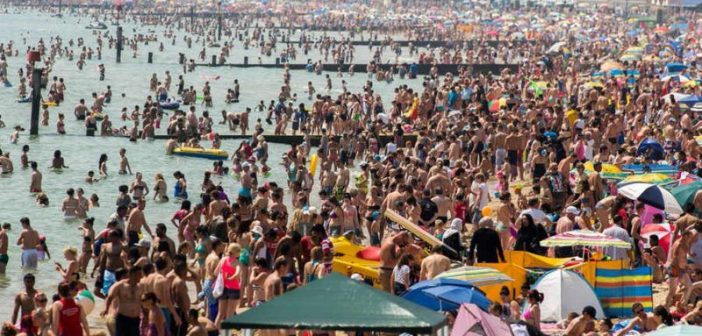This summer was a record breaking one in the UK with temperatures reaching 38.7. Whilst most of us enjoyed the somewhat rare British weather, should we be worried?
On the 25th July (2019) the mercury hit a record breaking 38.7 degrees at the Cambridge University Botanic Garden, making it the hottest temperature ever recorded in the UK. but with increasing concerns about the state of the climate, and a climate emergency agreed here in , Bournemouth,Christchurch and Poole, should all records be celebrated.
Some may also remember that we experienced very high temperatures last year too, with a temperature of 35.3 degrees recorded in Kent and an average temperature of 17.2 degrees, it was one of the hottest summers on record, in line with 2003, 2006 and the notorious summer of 1976.
With many news outlets publishing scary headlines about the state of our climate in direct reference to the temperature we’ve seen this year, and the Met Office using the phrase ‘unprecedented temperature highs’, exactly how worried should we be.
Two of the most notorious heatwaves in the UK are the summer of 1976, and the summer of 2003. 1976 is embedded in the national psyche as being the hottest summer seen in 350 years. The extremely hot and dry weather caused forest fires, and locally we saw the devastation of 50,000 trees burnt at Hurn Forest.
The heatwave experienced in 2003 left Europe sweltering and caused widespread health problems. There were over 20,000 deaths caused by the heatwave, and with 15,000 of these in France, mortuaries ran out of space. It was the hottest summer seen in over 500 years.
The met Office warns that: “Summers as hot as 2003 could happen every other year by 2050 as a result of climate change due to human activities.” – a rather scary prospect.
But lets look at the facts behind the scary headlines.
When records began in 1910, the average temperature that summer was 17.48 degrees. Fast forward to 2019, the average temperature we saw this summer was 19.35, an increase of 1.87 degrees in nearly 110 years… so it seems.
From this data, and the stories published in the press, it would be easy to assume that this has been a linear pattern of temperature increase, but in fact this assumption could be wrong. If we jump all the way back to 1911, a year after the weather records began, the average temperature for summer that year was 20.19 degrees! – hotter than the summer this year and hotter than any of the summers we’ve seen for the past 12 years, bar one – the heatwave of last year.
With all the doomsday headlines, it’s easy to get lost in the various statistics and facts regarding climate change. Few people dispute that our world and its environment is under pressure from an ever increasing population but just how critical is our situation?
Our climate is changing
The fact remains that the climate is changing and the 21st century has been warmer than the previous three centuries. Climate change is increasing the intensity and frequency of extreme weather. So should we be panic?
BH Living spoke to Nicola Maxey from the Met Office who explained the current state of the climate, and what we can expect to see in the future: “Taking action is vital. Without proactive adaptation to climate change we face significant negative impacts. The chance of severe heatwave in Europe, such as the 2003 heatwave which killed 2,000 people in the UK, has already at least doubled due to climate change.
“Flood events, such as the storms in December 2015 across Lancashire and Cumbria are also expected to become more likely. The planet faces a range of scenarios depending on the level of continuing greenhouse gas emissions. Some change is inevitable but the extent and severity of long-term climate disruption depends on future emissions.”
So what can we do to help?
Greenhouse gasses such as Carbon Dioxide, Methane and Nitrous Oxide a huge contributors to climate change, with their ability to trap heat, are seen as the human contributor to global warming, with carbon dioxide seen as the biggest villain.
In 2017 here in Bournemouth, Christchurch and Poole we emitted 1378 Kilotons of Co2 (carbon dioxide). Although the last 3 years has seen a reduction in carbon emissions across the BCP area, more needs to be done to ensure the future of our climate, and it starts with reducing our individual carbon footprints.
A Carbon Footprint is ‘the amount of carbon dioxide released into the atmosphere as a result of the activities of a particular individual, organization, or community.’ The average family of 4 creates 10 tonnes of CO2 emissions each year, that is the equivalent of filling 24 millions balloons with carbon!
Nicola Maxey from The Met Office explains just how much of an impact our carbon footprint is having on the climate: “The latest Assessment Report of the Intergovernmental Panel on Climate Change (IPCC) states that warming of the climate system is unequivocal, and that it is extremely likely (>95% confidence) that human influence has been the primary cause of warming. General climate change trends projected over UK land for the 21st century are broadly showing an increased chance of milder, wetter winters and hotter, drier summers along with an increase in the frequency and intensity of extremes.”
The biggest contributors to your carbon footprint are food consumption, transport and household energy and there are quick and easy things you can do to reduce your carbon footprint, for example:
- Only fill the kettle with the amount of water you need to boil
- On nice days, hang out washing instead of using the tumble drier
- Turn down your heating by 1 degree – this can reduce your annual energy consumption by 8%
- Using public transport more or even cycling/walking instead of driving your car
- Reducing your use of single use plastics – lots of energy and therefore polution go into producing single use plastics only for them to be thrown away – often into landfill
- Growing your own vegetables and herbs so you’re not relying on them being transported to your local store for you to buy.
If you’re looking at reducing your carbon footprint when you travel, you may want to consider an electric car, if so, read our article ‘The Future Is Electric’ in the BH Living magazine Autumn edition!
For more ideas and inspiration on reducing your Carbon Footprint check out these ideas


